
@ @@@@@@@ (Only in Japanese)
Current Research
1. Energy strategy
@Energy issues consist of real sustainability, connectivity of step-by-step improvement, robustness to uncertainties, and environmental issues. For the resolution of energy issues we have been investigating and proposing the energy technology strategy toward 2100, 2050 and 2030.
Based on the Long-term Energy Vision 2100, we studied the total areas of energy demand and supply including renewable energy, demand technology, distributed energy management and power system demand/supply management, to contribute to the annual Energy Technology Strategy Map and Cool Earth Energy Strategy Innovative Program.
In parallel with the progress of the global environmental issues, we explore the enabling combination of the innovative technology, the social institutions and the life style.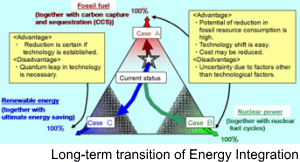
Based on the Long-term Energy Vision 2100, we studied the total areas of energy demand and supply including renewable energy, demand technology, distributed energy management and power system demand/supply management, to contribute to the annual Energy Technology Strategy Map and Cool Earth Energy Strategy Innovative Program.
In parallel with the progress of the global environmental issues, we explore the enabling combination of the innovative technology, the social institutions and the life style.

2. Long-range Material and Energy
@For the real sustainable socio-economic system, we develop the analysis and evaluation tool of the unified optimization of the production/utilization/recuperation of material and energy. The tool should have the resolution of plant vintage and the index generation. Through the utilization of the tool, we investigate and research for the future energy system optimization of a region, a nation and the world.
@Under the final target, we have started the collaborative analysis of an energy model and a power system model for Japan from the present to 2050. The analysis reflects the transmission of energy demand such as introduction of an electric vehicle, the renewable energy penetration under the constraint of power system demand-supply balancing capability to evaluate various scenarios including energy storage.
@We explore the robust and optimum transition of the material and energy demand-supply structure with the innovative technology dissemination of the production, utilization and recuperation including the infrastructure reformation.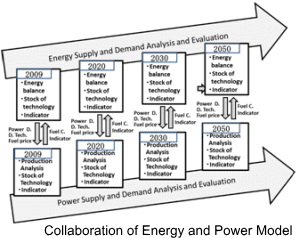
@Under the final target, we have started the collaborative analysis of an energy model and a power system model for Japan from the present to 2050. The analysis reflects the transmission of energy demand such as introduction of an electric vehicle, the renewable energy penetration under the constraint of power system demand-supply balancing capability to evaluate various scenarios including energy storage.
@We explore the robust and optimum transition of the material and energy demand-supply structure with the innovative technology dissemination of the production, utilization and recuperation including the infrastructure reformation.

3. Dynamic Energy Integration Analysis/Evaluation
@In a future power system, the increase of variable renewable energy, nuclear and coal-gasification generation plants at the supply side and energy storage devices such as hot water tanks and batteries will affect the optimum energy mix under the careful analysis of the dynamic demand-supply balance. We are developing the analysis tool of the dynamic energy analysis and evaluation and the data base, and also proposes the optimization of the energy mix and appropriate operation/control system through the analysis.
@One of the emerging requirements of a future power system is the reinforcement of demand-supply balancing capability, due to the increase of variable renewable generation and fixed generation of a base load power plant, and decrease of operation share of controllable thermal and hydro power plants. In order to fix the issues, the improved capability and operation of traditional power plants, generation forecast and curtailment of renewable energy generation, activation of demand including batteries can be applicable. With an improved probabilistic demand-supply model, we are beginning to analyze and evaluate the future scenarios from now to 2030.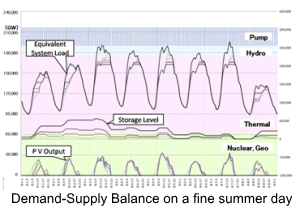
@One of the emerging requirements of a future power system is the reinforcement of demand-supply balancing capability, due to the increase of variable renewable generation and fixed generation of a base load power plant, and decrease of operation share of controllable thermal and hydro power plants. In order to fix the issues, the improved capability and operation of traditional power plants, generation forecast and curtailment of renewable energy generation, activation of demand including batteries can be applicable. With an improved probabilistic demand-supply model, we are beginning to analyze and evaluate the future scenarios from now to 2030.

4. Energy Management (HEMS/BEMS) and Renewable Energy
@Variation is the difficult feature of renewable energy generationies for their high penetration. Because renewable energies are located at or near the demand-side, the intermittency can be effectively compensated by the control of a demand, distributed generation, distributed energy storage at a demand-side. We are developing the optimum configuration of demand-side energy technologies and optimum control of Home/Building Energy Management System (HEMS/BEMS, which enable the maximum use of renewable energy, optimum cooperative control of centralized/decentralized energy management, keeping the quality of life which the energy is used.
@From 2009, including the funding of Japan Government, we developed the total concept of the harmonization of central/distributed energy management consisting of renewable energy generation forecast with smoothing effect, central/distributed energy management, their direct and indirect communication. The harmonization will remarkably enhance the demand-supply balancing capability of a power system.
@We are planning to complete the specification of a central/distributed energy management through analysis and evaluation of the harmonization and consideration of institutional matters to realize the scheme.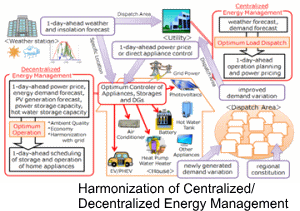
@From 2009, including the funding of Japan Government, we developed the total concept of the harmonization of central/distributed energy management consisting of renewable energy generation forecast with smoothing effect, central/distributed energy management, their direct and indirect communication. The harmonization will remarkably enhance the demand-supply balancing capability of a power system.
@We are planning to complete the specification of a central/distributed energy management through analysis and evaluation of the harmonization and consideration of institutional matters to realize the scheme.

5. Asset Management
@The infrastructure which supports the human social and economic activities requires management and maintenance through its long service life. The effect of management and maintenance are enhanced not only by technologies of each asset type but also by effective human decision and activities based on the database of an asset and its operation. The asset management, which has been focusing on a large asset, should be expanded to cover the distributed system such as distributed PV systems in the energy sector, including operation management.
@We surveyed the asset risk management for 3years in a research team to publish a book mentioning EAM (Enterprise Asset Management). We started to develop PV system remote diagnosis system in 2010.
@We are continuing the research activities to survey the methodology for management of central/distributed asset, and enhance the research of several areas including that for the distributed PV system.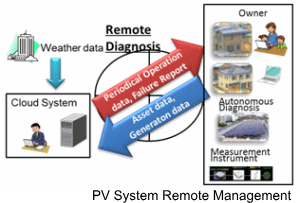
@We surveyed the asset risk management for 3years in a research team to publish a book mentioning EAM (Enterprise Asset Management). We started to develop PV system remote diagnosis system in 2010.
@We are continuing the research activities to survey the methodology for management of central/distributed asset, and enhance the research of several areas including that for the distributed PV system.
